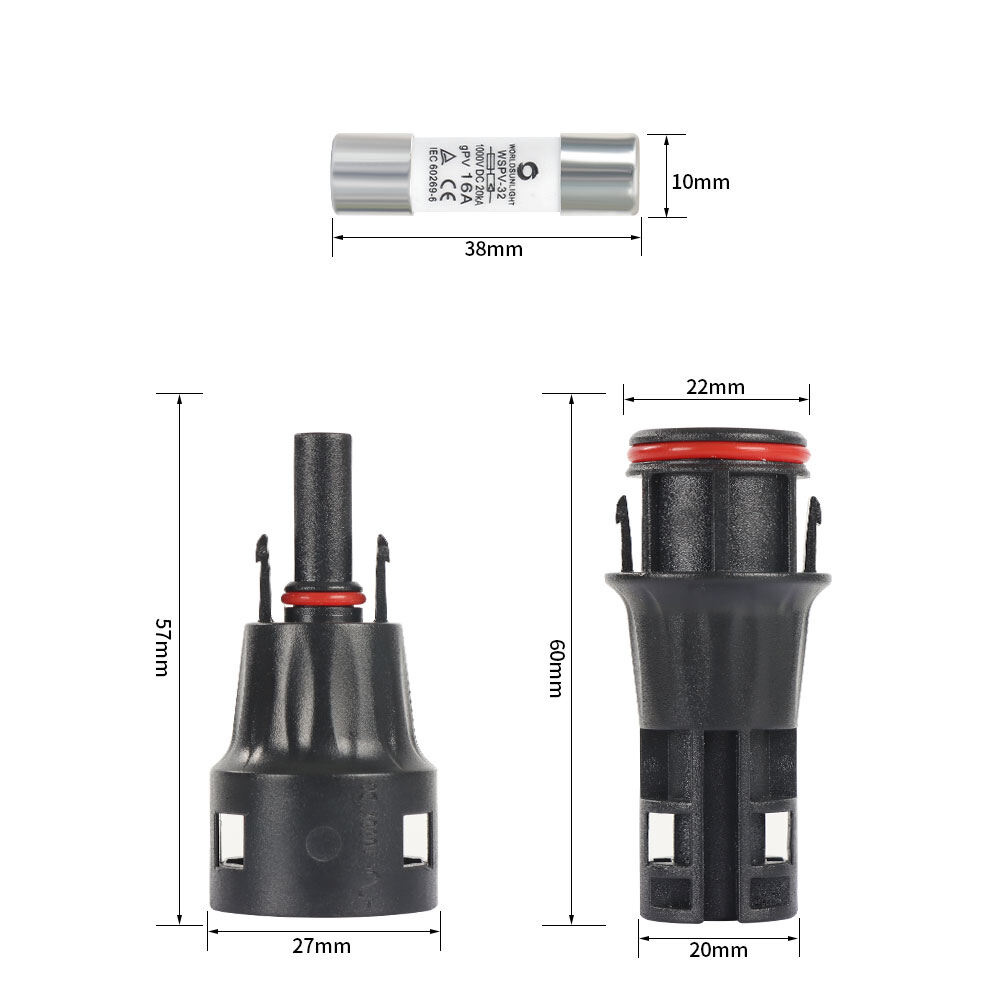Understanding the Essential Role of Connection Systems in Solar Power
The backbone of any efficient solar power system lies in its ability to reliably transmit energy from solar panels to the rest of the electrical infrastructure. At the heart of this transmission system is the photovoltaic connector, a seemingly simple yet sophisticated component that plays a pivotal role in ensuring the safe and efficient operation of solar installations. These specialized connectors serve as the crucial links that join solar panels together and connect them to inverters, creating an integrated system capable of delivering clean, renewable energy.
In modern solar installations, the significance of a high-quality photovoltaic connector cannot be overstated. These components must withstand extreme weather conditions, maintain consistent electrical connections, and ensure system longevity - all while meeting strict safety standards and performance requirements. As solar energy continues to grow as a primary source of renewable power, understanding the critical nature of these connectors becomes increasingly important for installers, maintenance professionals, and system designers alike.
Core Components and Design Features
Advanced Materials and Construction
The durability and performance of a photovoltaic connector stem from its carefully selected materials and precise construction. Modern connectors typically feature high-grade thermoplastic housing that offers excellent UV resistance and maintains structural integrity even after years of exposure to harsh environmental conditions. The metal contacts within these connectors are usually made from tin-plated or silver-plated copper, providing superior conductivity while resisting corrosion.
Internal components are engineered with precision to ensure maximum surface contact area between mating parts, reducing electrical resistance and heat generation. The latest designs incorporate advanced sealing mechanisms, including multiple contact points and specialized O-rings, to maintain a watertight connection that prevents moisture ingress and potential system failures.
Safety Mechanisms and Protection Features
Safety is paramount in photovoltaic connector design, with multiple built-in features to prevent accidents and system failures. Modern connectors include touch-proof designs that eliminate the risk of accidental contact with live components. Locking mechanisms ensure connections remain secure once established, while visual and tactile indicators confirm proper mating.
Advanced photovoltaic connectors also incorporate polarization features that prevent incorrect connections, reducing the risk of reverse polarity issues that could damage expensive solar equipment. Many designs now include integrated arc protection and short circuit prevention mechanisms, further enhancing system safety and reliability.
Environmental Resilience and Performance Standards
Weather Resistance Capabilities
The ability to withstand diverse environmental challenges is a defining characteristic of quality photovoltaic connectors. These components are designed to perform reliably in temperature extremes ranging from -40°C to +85°C or beyond. The housing materials are specifically formulated to resist UV degradation, preventing brittleness and maintaining structural integrity even after decades of sun exposure.
Salt spray resistance is another crucial feature, particularly for installations in coastal areas where corrosive conditions can severely impact electrical connections. Leading photovoltaic connector designs undergo rigorous testing to ensure they maintain their protective properties in high-humidity environments and withstand exposure to various atmospheric pollutants.
Compliance and Certification Requirements
Quality photovoltaic connectors must meet stringent international standards and certification requirements. These include IEC 62852 for safety and performance, UL 6703 for North American markets, and various regional certifications that ensure compatibility with local electrical codes. Manufacturers must demonstrate compliance through extensive testing protocols that evaluate everything from contact resistance to flame retardancy.
The certification process involves long-term durability testing, including thermal cycling, mechanical stress evaluation, and accelerated aging tests. These assessments help predict connector performance over the expected 25+ year lifespan of solar installations, providing confidence in their long-term reliability.
Installation and Maintenance Considerations
Proper Installation Techniques
The effectiveness of a photovoltaic connector largely depends on proper installation practices. Technicians must follow specific procedures for cable preparation, including precise stripping lengths and proper crimping techniques. The importance of using matched components cannot be overstated - mixing different brands or types of connectors can lead to connection failures and potential safety hazards.
Installation tools must be properly calibrated and maintained to ensure consistent crimping force and connection quality. Many manufacturers now provide specialized tools designed specifically for their connector systems, helping to eliminate variables that could compromise connection integrity.
Maintenance and Inspection Protocols
Regular maintenance of photovoltaic connectors is essential for ensuring long-term system reliability. Inspection protocols should include visual checks for physical damage, thermal imaging to identify potential hot spots, and resistance testing to verify connection quality. Any signs of degradation, such as discoloration or deformation, warrant immediate attention.
Preventive maintenance practices, such as checking connection tightness and cleaning accumulated dirt or debris, help extend connector lifespan and maintain optimal performance. Documentation of maintenance activities and findings provides valuable data for system optimization and future troubleshooting.

Future Trends and Innovations
Smart Connection Technologies
The evolution of photovoltaic connectors continues with the integration of smart technologies. New designs incorporate sensors that monitor connection quality, temperature, and electrical parameters in real-time. This data can be transmitted to system monitoring platforms, enabling predictive maintenance and early detection of potential issues.
Advanced connectors are being developed with built-in diagnostic capabilities, allowing for remote monitoring and automated alert systems. These features help reduce maintenance costs and improve system reliability by identifying problems before they lead to failures.
Sustainable Manufacturing and Materials
Environmental consciousness is driving innovation in connector manufacturing processes and material selection. Manufacturers are exploring bio-based plastics and recycled materials that maintain the required performance characteristics while reducing environmental impact. New production methods aim to minimize waste and energy consumption without compromising product quality.
Research continues into materials that offer enhanced durability and performance while being more environmentally friendly throughout their lifecycle. This includes developing connectors that are easier to recycle at end-of-life, supporting the circular economy principles increasingly important in the renewable energy sector.
Frequently Asked Questions
How long do photovoltaic connectors typically last?
Quality photovoltaic connectors are designed to last for the entire lifespan of a solar installation, typically 25-30 years. However, this depends on factors such as environmental conditions, installation quality, and maintenance practices. Regular inspections and proper installation are crucial for achieving maximum service life.
Can different brands of photovoltaic connectors be used together?
While technically possible in some cases, mixing different brands of connectors is not recommended and often violates safety codes and warranty requirements. Using mismatched connectors can lead to poor connections, increased resistance, and potential safety hazards. Always use the same brand and type of connector within a system.
What are the key indicators that a photovoltaic connector needs replacement?
Signs that indicate connector replacement include visible physical damage, discoloration, loose connections, increased connection resistance, hot spots detected during thermal imaging, or any evidence of water ingress. Regular system performance monitoring can also help identify connector issues through changes in power output or efficiency.




